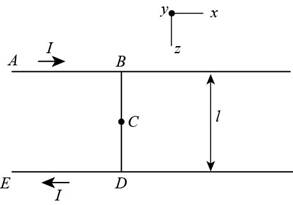
Concept explainers
Review. Rail guns have been suggested for launching projectiles into space without chemical rockets. A tabletop model rail gun (Fig. P29.42) consists of two long, parallel, horizontal rails ℓ = 3.50 cm apart, bridged by a bar of mass m = 3.00 g that is free to slide without friction. The rails and bar have low electric resistance, and the current is limited to a constant I = 24.0 A by a power supply that is far to the left of the figure, so it has no magnetic effect on the bar. Figure P29.42 shows the bar at rest at the midpoint of the rails at the moment the current is established. We wish to find the speed with which the bar leaves the rails after being released from the midpoint of the rails. (a) Find the magnitude of the magnetic field at a distance of 1.75 cm from a single long wire carrying a current of 2.40 A. (b) For purposes of evaluating the magnetic field, model the rails as infinitely long. Using the result of part (a), find the magnitude and direction of the magnetic field at the midpoint of the bar. (c) Argue that this value of the field will be the same at all positions of the bar to the right of the midpoint of the rails. At other points along the bar, the field is in the same direction as at the midpoint, but is larger in magnitude. Assume the average effective magnetic field along the bar is five times larger than the field at the midpoint. With this assumption, find (d) the magnitude and (e) the direction of the force on the bar. (f) Is the bar properly modeled as a particle under constant acceleration? (g) Find the velocity of the bar after it has traveled a distance d = 130 cm to the end of the rails.
Figure P29.42

(a)
Answer to Problem 42AP
Explanation of Solution
Given info: The length of the rails is
Formula to calculate the magnetic field is
Here,
Substitute
Conclusion:
Therefore, the magnitude of the magnetic field at a distance of
(b)
Answer to Problem 42AP
Explanation of Solution
Given info: The length of the rails is
The diagram that represents the given situation is shown below.

Figure (I)
Since the current is diverted through the bar, only half of each rails carries currents, so the field produce by each rail is half of the infinitely long wire produces.
Write the expression for the magnetic field produce by conductor AB at point C is,
Substitute
Write the expression for the magnetic field produce by conductor DE at point C is,
Substitute
Formula to calculate the total magnetic field at point C is,
Substitute
Conclusion:
Therefore, the magnitude of the magnetic field at the mid-point of the bar is
(c)
Answer to Problem 42AP
Explanation of Solution
Given info: The length of the rails is
The assumption makes that the rails are infinitely long so, the length of the rail to the right of the bar does not depend upon the location of the bar. Hence the magnetic field will be same at all position of the bar to the right of the midpoint of the rails.
Conclusion:
Therefore, due to infinite length of the rails makes the field same at all position of the midpoint of the bar.
(d)
Answer to Problem 42AP
Explanation of Solution
Given info: The length of the rails is
Formula to calculate the force on the bar is,
Here,
Substitute
Conclusion:
Therefore, the magnitude of the force on the bar is
(e)
Answer to Problem 42AP
Explanation of Solution
Given info: The length of the rails is
The force vector on the bar is
Conclusion:
Therefore, the direction of the force on the bar is in positive x-direction.
(f)
Answer to Problem 42AP
Explanation of Solution
Given info: The length of the rails is
The length of the bar, value of current and field producer is constant so, the force exerted on the bar is constant that gives uniform acceleration of the bar.
Formula to calculate the acceleration of the bar is,
Substitute
Conclusion:
Therefore, the bar will move with constant acceleration of magnitude
(g)
Answer to Problem 42AP
Explanation of Solution
Given info: The length of the rails is
Formula to calculate the velocity of the bar is,
Here,
Substitute
Conclusion:
Therefore, the velocity of the bar is
Want to see more full solutions like this?
Chapter 29 Solutions
Webassign Printed Access Card For Serway/jewett's Physics For Scientists And Engineers, 10th, Single-term
- A force acting on a particle moving in the xy plane is given by F = (2yî + x²), where F is in newtons and x and y are in meters. The particle moves from the origin to a final position having coordinates x = 5.60 m and y = 5.60 m, as shown in the figure below. y (m) B (x, y) x (m) (a) Calculate the work done by F on the particle as it moves along the purple path (0 Ⓐ©). ] (b) Calculate the work done by ♬ on the particle as it moves along the red path (0 BC). J (c) Is F conservative or nonconservative? ○ conservative nonconservativearrow_forwardA 3.5-kg block is pushed 2.9 m up a vertical wall with constant speed by a constant force of magnitude F applied at an angle of 0 = 30° with the horizontal, as shown in the figure below. If the coefficient of kinetic friction between block and wall is 0.30, determine the following. (a) the work done by F J (b) the work done by the force of gravity ] (c) the work done by the normal force between block and wall J (d) By how much does the gravitational potential energy increase during the block's motion? ]arrow_forwardPhysics different from a sea breeze from a land breezearrow_forward
- File Preview Design a capacitor for a special purpose. After graduating from medical school you and a friend take a three hour cruise to celebrate and end up stranded on an island. While looking for food, a spider falls on your friend giving them a heart attack. Recalling your physics, you realize you can build a make-shift defibrillator by constructing a capacitor from materials on the boat and charging it using the boat's battery. You know that the capacitor must hold 100 J of energy and be at 1000 V (fortunately this is an electric boat which has batteries that are 1000 V) to work. You decide to construct the capacitor by tightly sandwiching a single layer of Saran wrap between sheets of aluminum foil. You read the Saran wrap box and fortunately they tell you that it has a thickness 0.01 mm and dielectric constant of 2.3. The Saran wrap and foil are 40 cm wide and very long. How long is the final capacitor you build that saves your friend?arrow_forwardHow do I plot the force F in Matlba (of gravity pulling on the masses) versus spring displacement, and fit the data with a linear function to find the value for the spring constant. To get a linear fit, use polynomial order 1. Report the value of 'k' from the fit. What code is used?arrow_forwardOk im confused on this portion of the questions being asked. the first snip is the solution you gave which is correct. BUt now it is asking for this and im confused. The magnitude of the force F_11 is __________LB. The direction of the force F_11 is __________LB.arrow_forward
- Solve and answer the problem correctly and be sure to check your work. Thank you!!arrow_forwardThe spring in the figure has a spring constant of 1300 N/m. It is compressed 17.0 cm, then launches a 200 g block. The horizontal surface is frictionless, but the block’s coefficient of kinetic friction on the incline is 0.200. What distance d does the block sail through the air?arrow_forwardSolve and answer the problem correctly and be sure to check your work. Thank you!!arrow_forward
 Principles of Physics: A Calculus-Based TextPhysicsISBN:9781133104261Author:Raymond A. Serway, John W. JewettPublisher:Cengage Learning
Principles of Physics: A Calculus-Based TextPhysicsISBN:9781133104261Author:Raymond A. Serway, John W. JewettPublisher:Cengage Learning Physics for Scientists and Engineers: Foundations...PhysicsISBN:9781133939146Author:Katz, Debora M.Publisher:Cengage Learning
Physics for Scientists and Engineers: Foundations...PhysicsISBN:9781133939146Author:Katz, Debora M.Publisher:Cengage Learning Physics for Scientists and Engineers with Modern ...PhysicsISBN:9781337553292Author:Raymond A. Serway, John W. JewettPublisher:Cengage Learning
Physics for Scientists and Engineers with Modern ...PhysicsISBN:9781337553292Author:Raymond A. Serway, John W. JewettPublisher:Cengage Learning College PhysicsPhysicsISBN:9781938168000Author:Paul Peter Urone, Roger HinrichsPublisher:OpenStax College
College PhysicsPhysicsISBN:9781938168000Author:Paul Peter Urone, Roger HinrichsPublisher:OpenStax College College PhysicsPhysicsISBN:9781285737027Author:Raymond A. Serway, Chris VuillePublisher:Cengage Learning
College PhysicsPhysicsISBN:9781285737027Author:Raymond A. Serway, Chris VuillePublisher:Cengage Learning Physics for Scientists and EngineersPhysicsISBN:9781337553278Author:Raymond A. Serway, John W. JewettPublisher:Cengage Learning
Physics for Scientists and EngineersPhysicsISBN:9781337553278Author:Raymond A. Serway, John W. JewettPublisher:Cengage Learning





